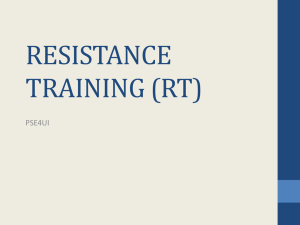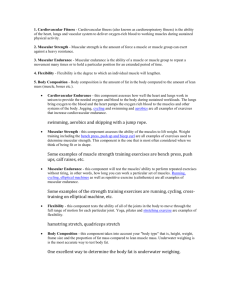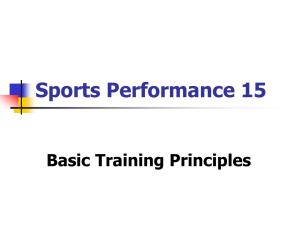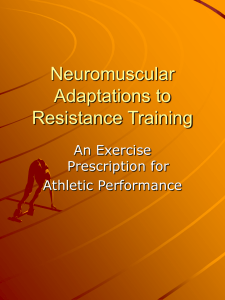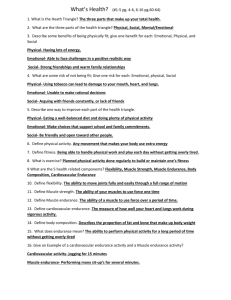Designing Effective Circuits
advertisement
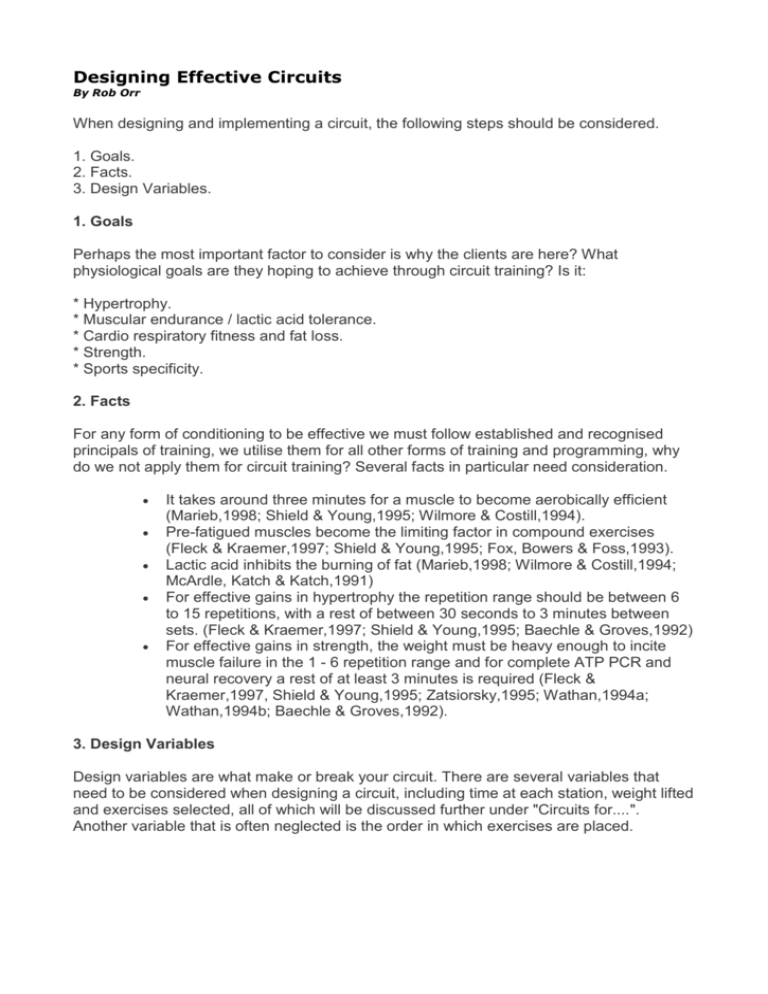
Designing Effective Circuits By Rob Orr When designing and implementing a circuit, the following steps should be considered. 1. Goals. 2. Facts. 3. Design Variables. 1. Goals Perhaps the most important factor to consider is why the clients are here? What physiological goals are they hoping to achieve through circuit training? Is it: * Hypertrophy. * Muscular endurance / lactic acid tolerance. * Cardio respiratory fitness and fat loss. * Strength. * Sports specificity. 2. Facts For any form of conditioning to be effective we must follow established and recognised principals of training, we utilise them for all other forms of training and programming, why do we not apply them for circuit training? Several facts in particular need consideration. It takes around three minutes for a muscle to become aerobically efficient (Marieb,1998; Shield & Young,1995; Wilmore & Costill,1994). Pre-fatigued muscles become the limiting factor in compound exercises (Fleck & Kraemer,1997; Shield & Young,1995; Fox, Bowers & Foss,1993). Lactic acid inhibits the burning of fat (Marieb,1998; Wilmore & Costill,1994; McArdle, Katch & Katch,1991) For effective gains in hypertrophy the repetition range should be between 6 to 15 repetitions, with a rest of between 30 seconds to 3 minutes between sets. (Fleck & Kraemer,1997; Shield & Young,1995; Baechle & Groves,1992) For effective gains in strength, the weight must be heavy enough to incite muscle failure in the 1 - 6 repetition range and for complete ATP PCR and neural recovery a rest of at least 3 minutes is required (Fleck & Kraemer,1997, Shield & Young,1995; Zatsiorsky,1995; Wathan,1994a; Wathan,1994b; Baechle & Groves,1992). 3. Design Variables Design variables are what make or break your circuit. There are several variables that need to be considered when designing a circuit, including time at each station, weight lifted and exercises selected, all of which will be discussed further under "Circuits for....". Another variable that is often neglected is the order in which exercises are placed. Exercise Order Guidelines The fixators or synergists involved in the selected exercise stations should be considered. This is particularly important if they have been utilised in the preceding station as prime movers. Eg. Abdominals before push-ups or lower back exercises before squats. By fatiguing the synergist / fixator muscles that stabilise the trunk, core stability is compromised. To reinforce this example, Egger, Champion and Bolton (1998,p.91), citing recommendations from the NSCA, state that 'exhausting the abdominals and lower back before squatting...can weaken the movement and lead to a possible injury.' Be wary of the effects of blood pooling. Avoid placing exercises that have the head in a lowered position after exercises that elevate the heart rate substantially, Eg. Shuttle sprint followed by sit-ups then stair climbing. During sit ups, there is a decrease in venous return from the legs (which are still receiving a vast amount of blood induced by the shuttle run), when the client suddenly stands up to move to the next station, blood has pooled in the lower limbs and this may cause fainting or dizziness in those with low blood pressure. For general circuit training, blood - muscle phasing should be consistent and effective. This means that the 'moving' of blood into different muscles should be progressive and 'smooth' as opposed to blood 'shunting 'or peripheral heart action. (Forcing blood to move rapidly to unused muscles). Specific circuit programs may purposefully utilise peripheral heart action. Eg. Training the transition phases of triathlons. Sports specific circuits should not have exercises that cause excessive fatigue prior to those requiring a higher level of technique. Eg. Military press prior to shooting basketball hoops. FAT LOSS & AEROBIC ENDURANCE : The aerobic system is utilised in both fat loss and aerobic endurance training and both training methods require compound movements that are continuous and rhythmic in nature, performed at a pace slow enough to facilitate ATP production via the oxidative system (Smith,1996; Shield & Young,1995;Roberts 1991). Both fat loss and C.V. training are best suited whilst in a 'steady state' or 'steady rate'. At this 'state / rate' lactic acid build up is minimal (McArdle, Katch & Katch,1991). The importance of this relates primarily to those seeking fat loss as lactic acid inhibits lipolysis (Marieb,1998; Wilmore & Costill,1994; McArdle, Katch & Katch,1991) A common statement by many claims that circuit training is not an effective form of C.V. training. Consider this; how effective is an aerobics class, primarily utilising smaller muscle groups with complex movements that are hardly ever repeated more than eight times before changing exercise? What about 'long slow distance' (LSD) training, with recommended heart rates between 60% and 80%? (Wilmore & Costill,1994; McArdle, Katch & Katch,1991). As Wilmore and Costill (1994,p.18) state 'LSD training is an excellent approach to general endurance training because it is effective and can be performed at a comfortable rate of work.' Another alternative is to design the circuit to resemble basic interval training. Eg. Lunges x 1 min, 1 Lap walk around the circuit, Squats x 1 min. Guidelines. Time at each station : Up to 60 secs Time on each muscle : Up to 3 mins The basic guideline is that it takes around three minutes for a muscle to become aerobically efficient (Marieb,1998; Shield & Young,1995; Wilmore & Costill,1994). With this in mind the same muscle group should be worked for at least three minutes. This can be done in a variety of ways. Two examples follow: 1. If you are working only one muscle group before changing to another, the station should last for at least 3 minutes (Young 1999,p.20) or alternately. 2. By utilising the same muscle group for at least three to four stations in a row Eg. Lunge Squat - Leg Press - Step Up - Shuttle run, your time on each station need only last a minute (Orr 1999,p.16) Weight lifted: Light The weight used needs to provide a training effect without causing excessive fatigue and lactic acid build up. A point to remember is that you are training at a sub maximal pace. Training harder would shift the training emphasis to lactic acid tolerance. A common fault is to start off too fast and fatigue with Lactic Build up. The aim should be to start off at a steady pace and maintain that cadence all the way through the work out. Exercise selection: Compound No minor muscle groups or isolation exercises To ensure the aerobic system remains active blood - muscle phasing must be effective. This should decrease the need for an anaerobic energy supply when shifting the training emphasis to a different muscle. Remember more effective aerobic and fat loss gains are made with specifically designed training programs. MUSCULAR ENDURANCE & LACTIC ACID TOLERANCE: Lactic acid tolerance and muscular endurance are related in the sense that 'Lactic Acid tolerance is an important factor in the development of muscular endurance...'(Shield & Young 1995,p.207). Although the ability to tolerate high levels of lactic acid may be of benefit in several sports and recreational activities, Shield and Young (1995,p.207) question the need for your average circuit participant to have a high lactic acid tolerance. However it is acknowledged that general muscular endurance is an important factor in functional fitness, by providing the ability to carry out daily tasks without excessive fatigue. From the shoulder and forearm endurance required to carry equipment to the abdominal endurance required to stabilise the pelvis, muscular endurance plays an active role in everyday movement. With this in mind can muscular endurance be trained without training lactic tolerance? Yes. According to Shield and Young (1995,p.163) for lactic acid tolerance to be trained effectively 'Anaerobic threshold must be breached so that lactic acid accumulates and is maintained at high levels for a reasonable period of time.' With this in mind, muscular endurance training need not be lactic acid tolerance training. Although station times may remain the same, muscular endurance can be trained sub maximally with fatigue and lactic acid accumulation coming at the end of a station or muscle group. Guidelines. Time at each station : 30 secs to 60 secs Muscular Endurance As stated in most resistance training sources, muscular endurance training requires a repetition range of at least 15 plus (Fleck & Kraemer,1997; Wilmore & Costill,1994; Shield & Young,1995; Baechle & Groves,1992). These repetitions would take around 30 seconds to 60 seconds to complete. A study by Washburn et al.(as cited by Sharkey 1990,p.90) showed a 10 % per week short term endurance gain with subjects utilising a 15 - 25 RM. Lactic Acid 'As the lactic system can only operate at its maximum for approximately 30 seconds to 45 seconds it would be best overloaded with a work interval which lasts 30 seconds to 60 seconds.' (Shield & Young 1995,p.162) Weight lifted: Moderate Muscular Endurance The participant should aim to reach muscular failure around the 20 repetition range. A common fault, especially encountered amongst novices, is starting off too quickly and either reaching lactic thresholds or muscular failure too early. This causes them to slow or cease the work out at that station. The aim is to keep working at a constant pace through the duration of the station. Lactic Acid The weights used must be heavy enough to bring about a rapid increase in lactic levels but not so heavy as to cause premature muscle failure (or technique failure) Once failure is near the participant can lower the weight. This allows the participant to continue working rather than causing them to cease due to muscular failure. Exercise selection: Compound No minor muscle groups or isolation exercises To enable a more effective training benefit compound exercises should be utilised. This will help alleviate isolation specific muscular endurance or lactic acid tolerance. This would also prevent minor muscles becoming the limiting factor (due to pre-fatigue) when conducting compound exercises for the larger muscle groups. HYPERTROPHY: With hypertrophy in mind we should well apply our goal specific knowledge for hypertrophy training. That includes, reps, sets and rest protocols. To apply these protocols effectively, instructors must ensure that there is a rest between sets. If they do not, then they begin moving into the realm of muscular endurance with high muscular tension and lower neural drive. Training experience. It is noted that beginners make hypertrophy gains no matter what form of resistance training they adopt (Fleck & Kraemer,1997; Shield & Young,1995; Wilmore & Costill,1994; Sharkey,1990). Also note that only those who are of at least intermediate resistance training experience have a more accurate value of training to muscle failure. With this in mind we should note that true hypertrophy trainers have months of experience in the weight room and the guidelines below are for their benefit (when desiring a break from traditional weight training.). Guidelines. Time at each station : 20 secs to 40 secs. Weight lifted : Moderate to Heavy For hypertrophy gains the weight should be heavy enough to induce muscular failure at around 6 to 15 repetitions, depending on the reference. (Fleck & Kraemer,1997; Shield & Young,1995; Conroy & Earle,1994; Wilmore & Costill,1994; Sharkey,1990). No more than 20 seconds to 40 seconds should be needed to achieve this. Exercise selection : Compound No minor muscle groups or isolation exercises Compound before Isolation unless pre-fatiguing. Remember more effective hypertrophy gains are made with specific weight training programs, which are unlikely to include circuit training. STRENGTH Due to the training requirements for strength gains it is not possible to train for true (or max) strength in a circuit. Two primary reasons are: 1. The required training weight needs to be heavy enough to induce muscle failure between 1 repetitions and 6 repetitions. This training requires more advanced resistance training techniques and a spotter for safety, repetitions (Fleck & Kraemer,1997; Shield & Young,1995; Zatsiorsky,1995; Wathan,1994a), and 2. The recommended rest time for strength training, which allows for neural and ATP PCR recovery, is around 3 minutes (Fleck & Kraemer,1997; Shield & Young,1995; Zatsiorsky,1995; Wathan,1994b). With these factors in mind, the goal should become one of relative strength - endurance rather than true strength (Orr,1999). Guidelines. Time at each station: 20 secs to 40 secs. Weight lifted: As heavy as possible within SAFE limits. The weight or intensity must be high enough to ensure muscular failure as soon as possible. Exercise Selection: Compound & Functional The most effective form of strength - endurance training comes from using functional activities like body weight exercises, rope climbs, 'Lift and Carry', 'Game Form Exercises', Tug - of -War etc. If resistance training exercises are used the exercises should be compound or smaller muscle groups may become a limiting factor. Remember more effective strength gains are made with specifically designed training programs employing established strength training protocols. With the following guidelines how can we put it all together into one circuit session. Here is a basic simple rotation format : 60 Secs per station : Hypertrophy 30 - 40 Secs work / 20 - 30 Secs stretch, or 30 Secs work whilst partner spots / Swap over. Lactic Acid Tolerance 45 Secs work / 15 Secs Stretch Recovery (Beginner) 60 Secs work. (Intermediate – Advanced ) Muscular Endurance } Aerobic Endurance } 60 Secs work. Fat Loss } If that gets too monotonous an active recovery could be incorporated. Those requiring a rest interval during hypertrophy training or beginning lactic tolerance training, could walk / jog around the circuit, moving onto the next station as they return. Or how about an interval circuit - Work for two stations recover for one. There are many variations to a circuit, the main point to remember however, is to follow the established facts. Circuits are not a law unto themselves and must obey all other acknowledged training protocols Stations & Exercises Hypertrophy / Muscular Endurance Aerobic Endurance / Fat Loss A. Push Up A. Push Up B. Bench Press B. Bench Press C. Mil Press C. Mil Press D. Clean and Press D. Shuttle Run E. Upright Row E. Upright Row F. Chin ups F. Chin ups G. Seated / Bent Over Row G. Seated / Bent Over Row H. Deadlift H. Shuttle Run I. Squat I. Squat J. Lunge J. Lunge K. Rev Lunge K. Rev Lunge L. Jog * L. Jog* * The jog can be back to the start or around the circuit Hypertrophy Resistance heavy enough to ensure muscle fatigue / failure at between 8 – 15 repetitions. For time remaining after set stretch or utilise active recovery Run station for blood – muscle phasing and light active recovery before recommencement of circuit Muscular Endurance Resistance set to ensure muscle fatigue is achieved at the end of the set after 15 + repetitions. Light to no break between sets. (eg work for 45 - 50 seconds rest for 10 – 15 seconds before changing exercises. Run station for blood – muscle phasing and light active recovery before recommencement of circuit. (limited run stations to ensure high muscular workload Aerobic Endurance and Fat Loss Resistance light enough to ensure high muscle fatigue and lactic build up is minimal and that they can keep working at a constant rhythmic pace. No break between sets. More run stations included for continual aerobic loading Lactic Acid Tolerance Resistance heavy enough to ensure high muscle fatigue and lactic build up at the end of station time ie 60 Secs) No break between sets. Fast / sprint run stations can be used OR more muscle loading exercises (like for muscular endurance and hypertrophy can be used) References: Baechle, T.R. & Groves, B.R., (1992). Weight Training. Steps to Success. Champaign,IL : Human Kinetics. Conroy, B.P. & Earle, R.W., (1994). Bone, Muscle and connective tissue adaptations to physical activity in Essentials of Strength Training and Conditioning. ed. T.R. Baechle Champaign,IL : Human Kinetics. Egger, G., Champion, N. & Bolton, A., (1998). Fitness Leaders Handbook 4th Edition. Kenhurst,Syd: Kangaroo Press. Fleck, S.J. & Kraemer, W.J., (1997). Designing resistance training programs 2nd Edition. Champaign,IL : Human Kinetics. Fox, E.L., Bowers, R.W. & Foss, M.L., (1993). The Physiological Basis for Exercise and Sport 5th Edition.. Madison, Wisconsin: Brown and Benchmark. Marieb, E.N., (1998). Human Anatomy and Fitness 4th Edition. Massachusetts, NW: Benjamin / Cummings. Mc Ardle, W.D., Katch, F.I. & Katch, V.I., (1991). Exercise Physiology 3 rd Edition. Malvern PA : Lea & Febiger Orr, R., (1999). Are circuits effective? Network Magazine Vol 12 No3 July 1999. Neutral Bay: Syd. Network. Pp.16 - 17 Roberts, A.D, (1991) Physiological capacity for sports performance in Better Coaching Advanced Coach’s Manual ed. F. Pyke, Belconnen, ACT: Australian Coaching Council Sharkey, B.J., (1990). Physiology of Fitness. Champaign,IL : Human Kinetics. Shield, T. & Young, L.,(1995). Fitness a Systematic Approach. Coorparoo, Bne: Fitlink. Smith, P., (1996). Endurance Training. Fitlink Magazine 2nd Quarter 96. Coorparoo, Bne: Fitlink. Wathan, D., (1994a) Load Assignment in Essentials of Strength Training and Conditioning. ed. T.R. Baechle Champaign,IL : Human Kinetics. Wathan, D., (1994b) Rest periods in Essentials of Strength Training and Conditioning. ed. T.R. Baechle Champaign,IL : Human Kinetics. Wilmore, J.H. & Costill, D.L., (1994) Physiology of Sport and Exercise. Champaign,IL : Human Kinetics. Young, L. (1999). Are circuits effective? Network Magazine Vol 12 No3 July 1999. Neutral Bay: Syd. Network. Pp.18 - 20
